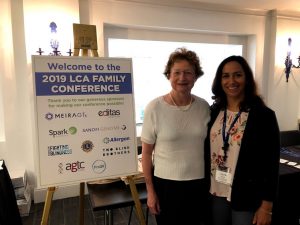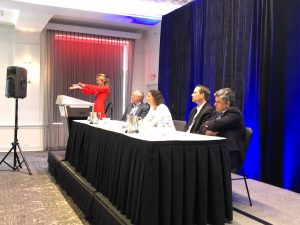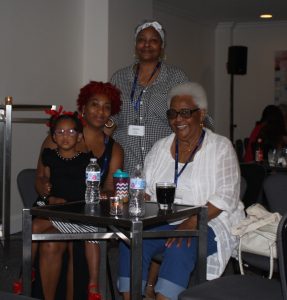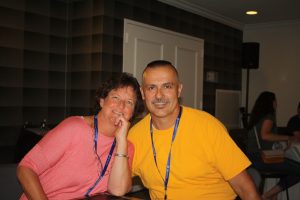LCA Family Conference 2019: A Lot to Unpack!
The news is out from our 2019 LCA Family Conference and it’s terrific!
Families living with Leber congenital amaurosis (LCA) and other rare inherited retinal diseases (IRDs) learned at Sofia Sees Hope’s July 27 conference in Philadelphia that they are living in a time of the most dramatic growth ever in genetic research.
And – as with most good things – there is a caveat: Patience.
While researchers report a record number of genetic studies in various stages, they face long and arduous journeys in developing federally approved treatments.
 In her keynote address, Dr. Katherine High, Co-founder, President and Chief Scientific Officer of Spark Therapeutics, said initiation of a clinical trial to licensing of a product easily can take 7 to 10 years.
In her keynote address, Dr. Katherine High, Co-founder, President and Chief Scientific Officer of Spark Therapeutics, said initiation of a clinical trial to licensing of a product easily can take 7 to 10 years.
“My take-home message is patience is a requirement in drug development.”
Dr. High and a team from Children’s Hospital of Philadelphia (CHOP) led by Dr. Jean Bennett and Dr. Albert Maguire from Spark Therapeutics developed LUXTURNA™, the first genetic therapy for any inherited rare disease in the United States and the first genetic therapy for RPE65, one of the more than 25 gene mutations caused by LCA.
The drug received federal approval in December 2017, creating the opportunity for visually impaired patients to undergo surgery and experience improved eyesight. Federal Food and Drug Administration (FDA) approval also signaled increased scientific and public optimism for expanding genetic research into treatments and cures for inherited diseases.
Connecting patients to patients
 More than 80 people – patients, family members, advocates, doctors, researchers and biotech industry leaders – gathered at the conference from July 26-28 at the Warwick Hotel Rittenhouse Square.
More than 80 people – patients, family members, advocates, doctors, researchers and biotech industry leaders – gathered at the conference from July 26-28 at the Warwick Hotel Rittenhouse Square.
The conference was sponsored by MeiraGTx, Editas Medicine, Spark Therapeutics, Sanofi Genzyme, Foundation Fighting Blindness, Allergan, ProQR, Two Blind Brothers, Applied Genetic Technology Corp. (AGTC) and Lions Clubs International.
Family members and advocates from throughout the country and Mexico said they appreciated the depth and quality of information presented at the conference that included information from other rare disease groups, the Young Adult Sickle Cell Alliance and the Barth Syndrome Foundation, on how they approach patient advocacy and patient life.
Laura Manfre, co-founder of Sofia Sees Hope and president of its Board of Directors, said the nonprofit’s second conference ever was designed to bring information to patients and families as well as connect those patients to researchers and industry.
“A huge part of our mission is to make sure that members of the rare disease community do not feel alone,” Manfre said. “And not only do we hear from patients all the time that they want to connect with other patients, but we hear from researchers and pharma that they not only want to talk to patients, but they need to do so, because it gives them context and perspective on their work. Our LCA Family Conference accomplished that 10-fold this year.”
Three generations of at least two families attended, with one family connecting directly with Spark for possible treatment of their 4-year-old daughter/granddaughter, Jordynn, who has LCA-RPE65, also known as LCA2.
 Jordynn’s mom, Joy Goodwine of upstate New York, said it was great to meet families with kids who have gone through the same experiences.
Jordynn’s mom, Joy Goodwine of upstate New York, said it was great to meet families with kids who have gone through the same experiences.
“Learning about the treatment and getting the education about all of it really gave me something to think about as my daughter’s journey continues as she lives with this visual impairment,” she said. “Knowing that my daughter can thrive and live a happy life with some occasional bumps in the road was a wonderful feeling.”
LCA research progress
Ben Yerxa, Ph.D., CEO of Foundation Fighting Blindness, told the group that awareness in genetics helped increase the number of people enrolled in My Retina Tracker®, a free and secure online registry with a goal to drive research toward prevention, treatments and cures for people living with a spectrum of inherited retinal degenerative diseases, including LCA.
 “I call it the LUXTURNA effect. It went up like a hockey stick,” he said of the more than 23,000 people now in the registry.
“I call it the LUXTURNA effect. It went up like a hockey stick,” he said of the more than 23,000 people now in the registry.
Dr. Yerxa reviewed LCA research progress, detailing 18 forms of the disease and highlighting study stages, including a current recruiting request by Editas Medicine and Allergan for patients for Phase 2 research on LCA-CEP290 (LCA10), and citing more than 35 select trials traveling through the clinical trial pipeline.
“We know it takes a village,” he said. “There are tons of people involved in these programs.”
In a session titled “Your Voice Matters,” patient advocates urged people to tell their stories. Terri Booker, Co-Founder of the Young Adult Sickle Cell Alliance, said she talks about her disease every chance she gets. She founded the youth alliance to empower young patients with advocacy tools to help them live longer.
Also included in the panel were Jamie Ring, Head of Patient Advocacy for Spark, Jill Dolgin, Head of Patient Advocacy for AGTC, and Emily Milligan, Executive Director of the Barth Syndrome Foundation.
Brian Mansfield, Ph.D., Executive Vice President of Research and interim Chief Scientific Officer at the Foundation Fighting Blindness, moderated a panel called “One Disease, Many Approaches.”
Attacking LCA on many fronts
The audience heard from Dr. Bennett about injection treatment, from Pam Stetkiewicz, Vice President of Program Management for Editas Medicine, about gene-editing treatment, and from Dr. Tomas Aleman on ways to measure the impact of therapies. Dr. Aleman is Director of the Center for Hereditary Retinal Degeneration at Perelman Center for Advanced Medicine and Director of Retinal Degeneration Service at the Center for Advanced Retinal Ocular Therapeutics (CAROT).
 Also, Michael Schwartz, Global Project Leader for Sepofarsen at ProQR, spoke about repairing the underlying defect in a nucleic acid and the potential to stop progression or reverse some effects of LCA10 or CEP-290.
Also, Michael Schwartz, Global Project Leader for Sepofarsen at ProQR, spoke about repairing the underlying defect in a nucleic acid and the potential to stop progression or reverse some effects of LCA10 or CEP-290.
Ben Shaberman, Senior Director of Scientific Outreach and Community Engagement at Foundation Fighting Blindness, moderated a third session: “All About Clinical Trials.” Dr. Wiley Chambers, the FDA’s Supervisory Medical Officer in the Office of New Drugs, cautioned those gathered about bogus trials, encouraging them to make sure their trial of interest received an FDA Investigational New Drug (IND) application number.
Dr. Michel Michaelides, Head of Clinical Ophthalmology at MeiraGTx, described other relevant treatments, such as optogenetics, a technique that uses light to control cells in living tissue, and retinal implant technology.
Tami Morehouse, who received the genetic therapy treatment for RPE65 during its trials, and her husband, Michael, rounded out the panel.
“She was on a pathway to darkness and she knew it,” Michael said. “It’s a huge life-changing event for us.”
 Tami became a global pioneer in the LCA world by being the oldest person at age 44 to receive the treatment during its clinical trials.
Tami became a global pioneer in the LCA world by being the oldest person at age 44 to receive the treatment during its clinical trials.
“In all honesty, I never thought that I’d ever have a shot at seeing,” she said. “I got way more than I anticipated.”

